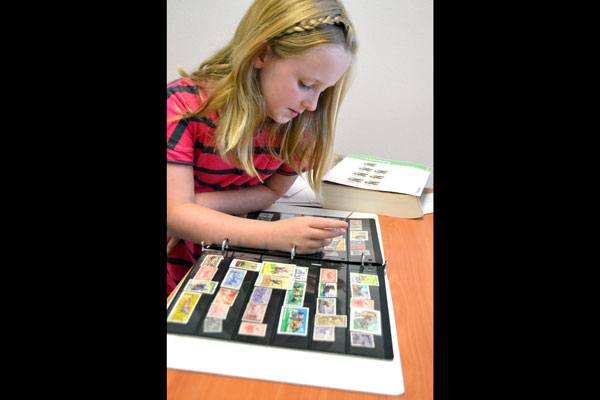Sequim newcomer Julie Callahan is traveling to great lengths to find just the right stamps.
As an avid world traveler and African animal activist, Callahan began collecting stamps through her friend Richard Tarbuck and learned of an array of stamps on her passions. Yet six months in, she’s learned 44 countries created hundreds of stamps over the years.
“Some places don’t even have gorillas, but they have gorilla stamps,” she joked.
No matter how specific you think your interests are, there always are more and more stamps say collectors with the Strait Stamp Society.
Neal Gamroth, another collector, said he collects a little of everything including Canadian stamps and revenues and that there are more than 200 main topics of stamps and thousands of variations.
Collectors can be even more specific.
He once met a man who only wanted postcards addressed to New York from 1874-1879.
Callahan tried to be specific and the hobby has grown into collecting stamps with masks, African animals and costumes. She’s trying to collect a stamp from every country she’s been, but she’s not quite sure how many that’s been.
“I have a lot of fun doing it,” she said. “There aren’t rules and I love that.”
Callahan presents three displays on her collections along with several other members at the Strait Stamp Society’s free annual stamp show on Aug. 10.
Cathie Osborne, show chairman, said it’s the only stamp show and club in the area.
“Since we’re the only stamp show on the North Olympic Peninsula, we have people waiting all year,” she said. “The dealers are excited to come every year. They say, ‘Be sure to invite me next year.’”
Each year, more collectors find their way into or back into stamps a number of ways — friends, family and even the president.
Tarbuck said he started collecting as a boy and was intrigued that President Theodore Roosevelt collected stamps.
The retired naval officer collects Japanese stamps after starting the collection with a pen pal and he looks for stamps from countries his father served in during World War II, such as New Guinea and Borneo.
“It’s easy to go off on a trail,” Tarbuck said. “You can find something pretty or something that just catches your eye.”
Stamp collecting covers all ages from Gene Haugen, who first pursued stamps for a merit badge in the Boy Scouts 70 years ago, and Ruby Coulson, 8, who just started a collection last week.
She likes Christmas stamps for their colors and availability, love and flags stamps for their variety and horse stamps because it’s her favorite hobby.
Haugen has a variety of stamps including 80,000 2-cent reds stamps from 1890-1895 that’s he been sorting for 10 years. He said there’s about a dozen different stamps with a certain stain or watermark that came wrapped up in a bundle of about 100 each during the Depression.
“I figure people (collect) for about five years or so and then get married, have children and careers and then get back into it when they retire like me,” Haugen said.
What’s it take?
The hobby can be as expensive as you want to make it, Tarbuck said.
He and Callahan went to a stamp shop and spent three hours looking for gorilla stamps. She found four stamps and spent 14 cents.
Phil Castell, another collector, said most near mint stamps are still worth their face value and that only ultra-rare stamps go up in value like the first Penny Black stamp from Great Britain in 1840 worth $13.50 near mint in 1924 and $10,000 near mint today in pricing catalogues.
He said one fun way to get into the hobby is to discover the penny table at the show.
Osborne said the stamp show reveals exactly what collectors do and their passion for the hobby.
“There’s free exhibits, free stamps for kids and it might be a good hobby that doesn’t take batteries,” she said.
“And if you have a collection you don’t know what to do with, dealers can tell you what it’s worth. Or you might just get excited about the hobby.”
The show also features a Sequim Centennial cancellation stamp while the society produced an envelope with the centennial logo on it for $1 and $2. The U.S. Postal Service will be there issuing the cancellation along with selling postage. The Sequim Post Office will offer the cancellation through Sept. 10.
For more information on the club, visit its meetings at 6 p.m. the first Thursday of every month at the Sequim Library, 630 N. Sequim Ave.
Reach Matthew Nash at mnash@sequimgazette.com.



